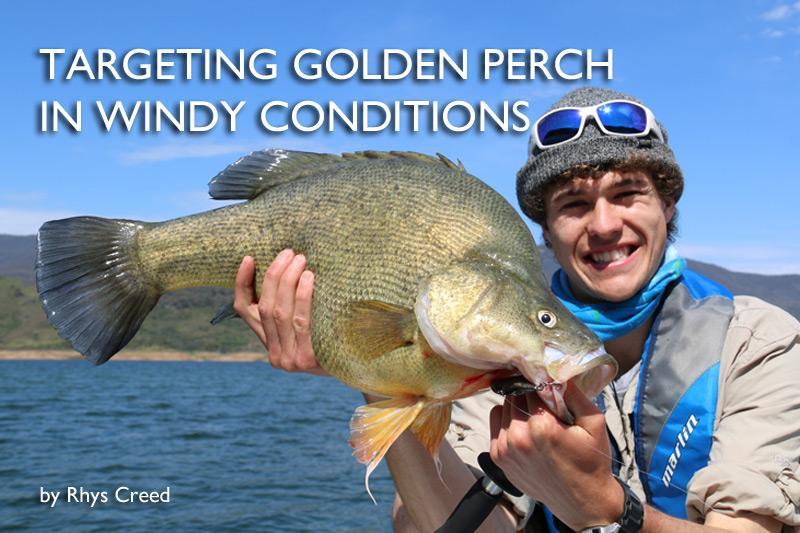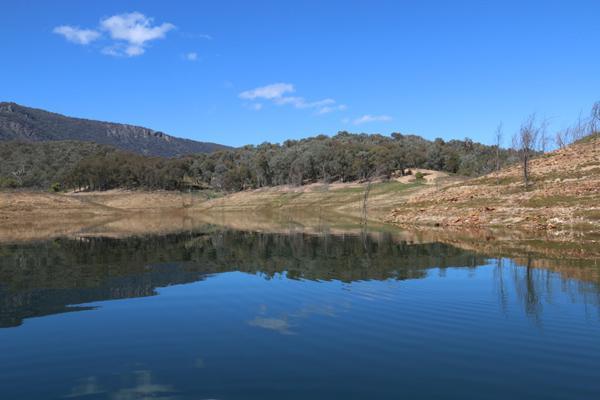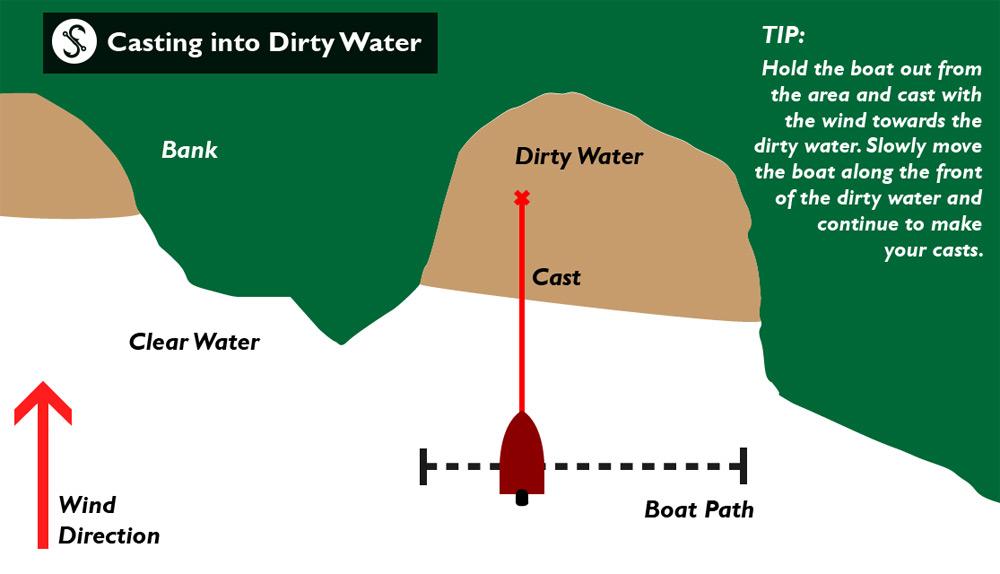Written by Rhys Creed
Nothing breaks your heart more than heading out on a fishing trip to see the trees swaying side to side. Even worse peering over the body of water expecting to see a mirror that brings a rush of excitement but instead it’s covered in rolling white caps.
Wind is an angler’s worst enemy and it can turn any day into an uncomfortable and sometimes dangerous one. I cannot remember the number of days that have been cut short due to the wind but instead of leaving, you can turn this into an advantage. When this wild breeze is blowing above the water’s surface there is something exciting happening underwater.
Using the Wind to your Advantage
Golden Perch can be an extremely picky fish, especially in the crystal clear waters of our big lakes and dams. They become intelligent, spooky and hard to catch on really sunny, clear and still days. You will find that the fish follow your lures up before turning away constantly all day long and this can become extremely frustrating. It’s exciting if they are taking your lures but frustrating when they continue to shy away.
When this happens, wind becomes your new best friend. Start to search for areas in the dam that are affected by wind: bays, rocky or clay points and creek inflows.
How does the Wind Help
Wind can play a vital role in turning Golden Perch on or any species that lives in a dam for that matter. The wind does a few different things to alter what’s happening underneath the water, not only does it bring the fish on the bite but you can pin point where they are going to be feeding.
1. Dirty Water
This is the best effect of the dirty water in terms of finding hungry fish. When the wind picks up it creates a choppy surface, which lifts the slit and mud from the banks creating dirty water. This boosts the Golden perch’s confidence as they cannot be seen as well. This means they can hide from predators and easily sneak up on their prey. This dirty water also lifts food up from the soil and reeds resulting in a buffet for the Golden’s.
2. Pushes Food
This reason is an all-time favourite when targeting Trout in lakes. What happens is the wind pushes all the food that is floating around to one side of the lake. This means the fish know exactly where all the food is going to be and they don’t have to expel too much energy searching. Always make sure you fish on the side in which the wind is blowing into.
3. Disturbed/Broken Surface Water
The broken surface water has a similar effect to that of the dirty water. It gives the Perch a feeling of confidence because they cannot be seen from above. In windy conditions and broken water it is very hard for us to be able to see beneath the water’s surface and this is what the Perch prefer.
Techniques and Approach
You want to seek out rocky points or bays where the water is dirtier than the rest of the lake and also areas that are choppy. Most of the time you will actually be able to see the colour change.
Colour Change and Dirty Water
Social Fishing Tip:
What is colour change?
Colour Change is a distinct line that can be seen where the water goes from its normal colour (usually clear or stained tea colour) to a dirty milk brown colour. This is very common on days that are extremely windy and the chop from the water dislodges mud and silt from the clay banks creating this area of dirty water.
This area of colour change is what you need to find. I can’t tell you how many times we have struggled to catch Golden Perch in the clear water and as soon as we start fishing in the dirty water, we are on! This dirty water is the perfect location for the fish to feed and provides them with a high confidence because they cannot be seen in the clear water.

Here you can see the colour change due to the high winds picking up slit from the point. These are the areas you want to target.
Social Fishing Tip:
Rule of thumb: If you can see the fish chances are they can see you. When you can’t see them, you’ll have more chance of landing them. This is why we catch so many more cod on surface during the dark. It’s all due to the level of confidence the fish has.
What happens is the Perch will patrol the edge of this colour change looking for food. Majority of the time if there is a fish in the area, they will be feeding and will aggressively take anything. There are a couple of different options when it comes to fishing in the colour change:
Diagram: Casting into the Dirty Water
This is the first technique that can be used when fishing the dirty water. Holding the boat out away from the colour change line (boat still in the clear water) and cast into the dirty water. From here you retrieve your lures through the dirty water and into the clear water. Most of the time the fish will attach the lure right on the colour change but we have also landed plenty of fish deep into the dirty water.
Diagram: Casting along the Colour Change
The next option is to cast along the length of the colour change. This can be difficult to execute properly because you have to remember you are trying to drive a boat in windy and choppy conditions. But if you can manage to hold the boat in line with the colour change you will have a good chance of finding hungry fish. This way you are effectively working the area where the fish are patrolling.
Like I said it can be a little tricky to implement and you can spook fish but it is a very successful technique. We usually do this after we have worked the area from a distance.
You can also work the colour change easily from the bank if the dirty water is running around a point.
Casting Effectively in Windy Conditions
Casting in these high wind conditions can be very difficult and with a few tips it will help you be more effective with casting, retrieving and minimising wind knots.
Casting with the Wind
This is the easiest way to fish the windy situations and it’s usually the most common. When you’re casting into the dirty water [like Casting into Dirty Water diagram] you will most likely have the wind behind you. The wind will be pushing into the bay or rocky point and if you line yourself up correctly and cast directly with the wind your lure will fly through the air. You’ll get more distance in your cast and you should also have very little bow in your line.
Social Fishing Tip:
Bow can be a huge problem when fishing in windy conditions. The wind can create a big bow in your line which means you lose direct feel and contact with your lure. This means you cannot fish it correctly, you won’t be able to feel if the lure is working correctly, chances are you will get more snags and you can miss bites from fish. This is why it’s important to avoid casting across the wind. Try to cast directly with or against the wind.
Casting into the Wind
The other option is to cast directly into the wind. This is a more commonly used technique when fishing from the bank and also when fishing a rocky or clay point. It works just the same as casting with the wind except you will get less distance in your cast. Your lure will still track straight through the air and you will get minimal bow compared to casting across wind.
Social Fishing Tip:
Tip: Top Lure Choices for Dirty Water
When the water is dirty we prefer to use a louder lure that is going to get the attention of the fish. In saying that if the water isn’t too dirty or the loud lures are spooking the fish you can use a more subtle presentation:
STYLE | BRANDS | |
Loud Lures | Lipless Crankbaits | Sebile FlattShad Jackall TN 50 & 60 Kokoda G-Vibe Rapala Rippin’ Rap |
| Spinnerbaits | Mud Guts ½ Oz | |
| Hard Body’s | 70m AC Invader 50mm Slim AC Invader 80mm Strikeforce Cod Stalker | |
Subtle Lures | Soft Plastics | Gulp! Minnow Grubs Powerbait T Tail Minnow Powerbait Ripple Shads |
All retrieves will work in the dirty waters like they do in other locations. Slow roll, hop and drop or burn and kill, they all catch fish. One thing that we do differently is how long we let the lure sink. In the dirty water you don’t have to have the lure on the bottom. The fish could be anywhere throughout the water column as they are up feeding on all the food. So we change up the depth in which we retrieve our lures.
On the bottom, mid water and just under the surface. Try them all and figure out where they are sitting. Personally I prefer to fish the lures in mid water as this is where we have had the most success.

As you can see the Perch are more aggressive in the dirtier water - this lipless crankbait was inhaled head first
The wind can be painful but it’s not all doom and gloom. You can turn this annoying weather condition into an advantage that takes you right to the feeding fish. Just remember these tips this spring when you are either battling that wind or struggling to find hungry Golden’s.
Rhys Creed








Really like the articles
Just reassures that we are doing the right things
Just not as good as you guys at getting the fish
But that’s fishing hey
Regards Terry
Hi Terry,
Glad you like the articles mate! We want to help as many people as we can.
Don’t you worry we all have our tough days, but it all comes down to more time on the water.
Cheers,
Rhys